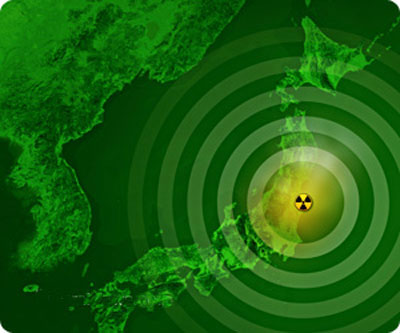300 Tons of Fukushima Nuclear Waste Pouring Into Ocean Every Day
Michael "Mish" Shedlock

Officials in Japan hid the fact that the Fukushima nuclear plant has been pouring hundreds of tons of nuclear waste water into the ocean every day and that a containment barrier has been breached.
Here are a few links.
On Tuesday the BBC reported Fukushima Radioactive Leak a New Emergency
Japan's nuclear watchdog has said the crippled Fukushima nuclear plant is facing a new "emergency" caused by a build-up of radioactive groundwater.
A barrier built to contain the water has already been breached, the Nuclear Regulatory Authority warned.
This means the amount of contaminated water seeping into the Pacific Ocean could accelerate rapidly, it said.
Last Friday, Energy News reported "Contaminated underground water may have moved above ground" at Fukushima plant
NHK, August 3, 2013: [...] TEPCO admitted during the [Friday] meeting that contaminated underground water may have moved above ground along seawalls that were solidified to stop leakages. TEPCO's proposals include construction of a new facility to gather underground water flowing toward the seaside of the plant and begin pumping water in late August. Experts in the group urged TEPCO to implement the measures ahead of schedule, citing the seriousness of the problem. [...]
Asahi Shimbun, August 3, 2013: [...] The immediate concern is radioactive water seeping along the seaward side of the No. 1 to No. 3 reactors and spilling into the sea. [...] the water level in observation wells has risen sharply to about 1 meter from the ground's surface, [...] the walls can only be built with their tops at 1.8 meters beneath the surface. That means the water levels in the observation wells have already risen above the top edges. If such a situation continues, the completed barriers will be unable to prevent the water from reaching the ocean. In addition, calculations show that if the water levels continue to rise at the current pace, contaminated water will flood the surface in about three weeks. [...]
300 Tons a Day of Nuclear Waste Water Per Day
On Wednesday, Reuters announced Japan says Fukushima leak worse than thought, government joins clean-up
Highly radioactive water from Japan's crippled Fukushima nuclear plant is pouring out at a rate of 300 tonnes a day, officials said on Wednesday, as Prime Minister Shinzo Abe ordered the government to step in and help in the clean-up.
The revelation amounted to an acknowledgement that plant operator Tokyo Electric Power Co (Tepco) has yet to come to grips with the scale of the catastrophe, 2 1/2 years after the plant was hit by a huge earthquake and tsunami. Tepco only recently admitted water had leaked at all.
The leak from the plant 220 km (130 miles) northeast of Tokyo is enough to fill an Olympic swimming pool in a week. The water is spilling into the Pacific Ocean, but it was not immediately clear how much of a threat it poses.
As early as January this year, Tepco found fish contaminated with high levels of radiation inside a port at the plant. Local fishermen and independent researchers had already suspected a leak of radioactive water, but Tepco denied the claims.
"We think that the volume of water (leaking into the Pacific) is about 300 tonnes a day," said Yushi Yoneyama, an official with the Minister of Economy, Trade and Industry, which oversees energy policy.
Tatsuya Shinkawa, a director in METI's Nuclear Accident Response Office, told reporters the government believed water had been leaking for two years, but Yoneyama told Reuters it was unclear how long the water had been leaking at the current rate.
Shinkawa described the water as "highly" contaminated.
Tepco and the industry ministry have been working since May on a proposal to freeze the soil to prevent groundwater from leaking into the reactor buildings.
Similar technology is used in subway construction, but Chief Cabinet Secretary Yoshihide Suga said that the vast scale of Tepco's attempt was "unprecedented in the world."
The technology was proposed by Kajima Corp, , a construction company already heavily involved in the clean-up.
Experts say maintaining the ground temperatures for months or years would be costly. The plan is to freeze a 1.4 km (nearly one mile) perimeter around the four damaged reactors by drilling shafts into the ground and pumping coolant through them.
"Right now there are no details (of the project yet). There's no blueprint, no nothing yet, so there's no way we can scrutinise it," said Shinji Kinjo, head of the task force set up by the nuclear regulator to deal with the water issue.
Fukushima Nuclear Plant Video, Slide Show
The Huffington Post Has additional details as well as a video and slideshow in Fukushima Leak Is An 'Emergency,' Watchdog Official Says
Tokyo Electric Power Co. (TEPCO), the plant's operator, admitted last month that contaminated water from Fukushima had leaked into the underground water system and reached the sea. The company gave its first estimate of the extent of the leak this weekend.
According to AFP, TEPCO estimates between 20 trillion and 40 trillion becquerels of radioactive tritium have spilled into the ocean.
UPI explains a becquerel is a unit of radioactivity, "the quantity of radioactive material in which one nucleus decays per second."
TEPCO long denied radioactive water had been leaking into the ocean, the AP notes, despite reports that biologists had found traces of radioactive cesium in fish. The operator eventually admitted to both the leak and having postponed acknowledgment the crisis.
There is no credibility from TEPCO or the Japanese government on the extent of the real disaster, its effects, the ultimate cleanup costs, or how many years fish in the area will be contaminated. In addition, contaminated fish may turn up anywhere within their normal swimming range with obvious implications.
www.sitkapacific.com |


